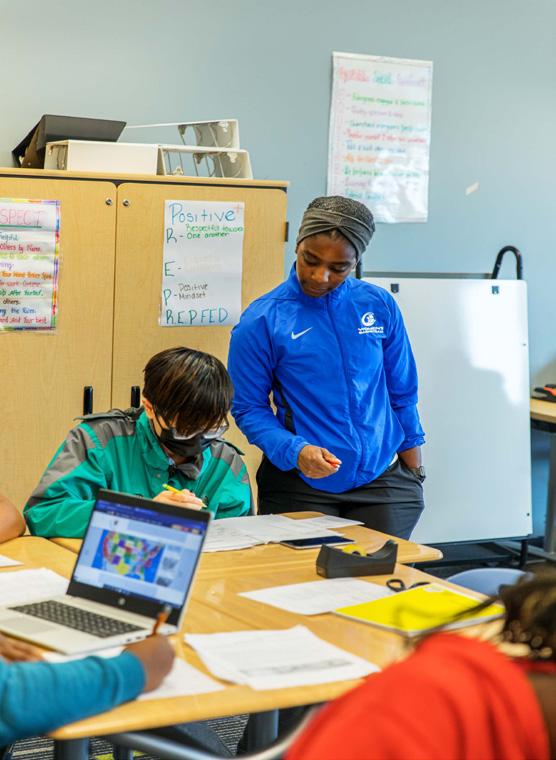




MTSS is a comprehensive, continuum of evidence-based systems practices to support a rapid response to scholars’ academic, social-emotional, and behavioral needs.

There are 6 key tenets within a MTSS Framework:
• All scholars are capable of grade-level learning with adequate support.
• MTSS is rooted in proactivity and prevention.
• The system utilizes evidence-based strategies.
• Decisions and procedures are driven by school and scholar data.
• The degree of support given to scholars is based on their unique needs.
• Implementation occurs school-wide and requires collaboration.
We have kicked off the year with a focus on 6 CEL5D focus indicators. This first semester, we have been focusing on high-quality, culturally responsive, Tier 1 instruction through our system-wide focus on SE5: Scholar Talk and CEC2: Learning Routines. As we move into January and February, we will be layering in a focus on SE1: Quality of Questioning and SE4: Scholar Meaning Making.
Second Semester Focus:
• Elementary will focus on building structures for Tier 2 interventions in ELA and Tier 1 differentiation in math. The key learnings will be around data-based decision making and high-quality small group instruction.
• Secondary will focus on building master schedules, within our current structures, that provide time for explicit Tier 2 interventions while also learning about integrating high-quality small group instruction into Tier 1.

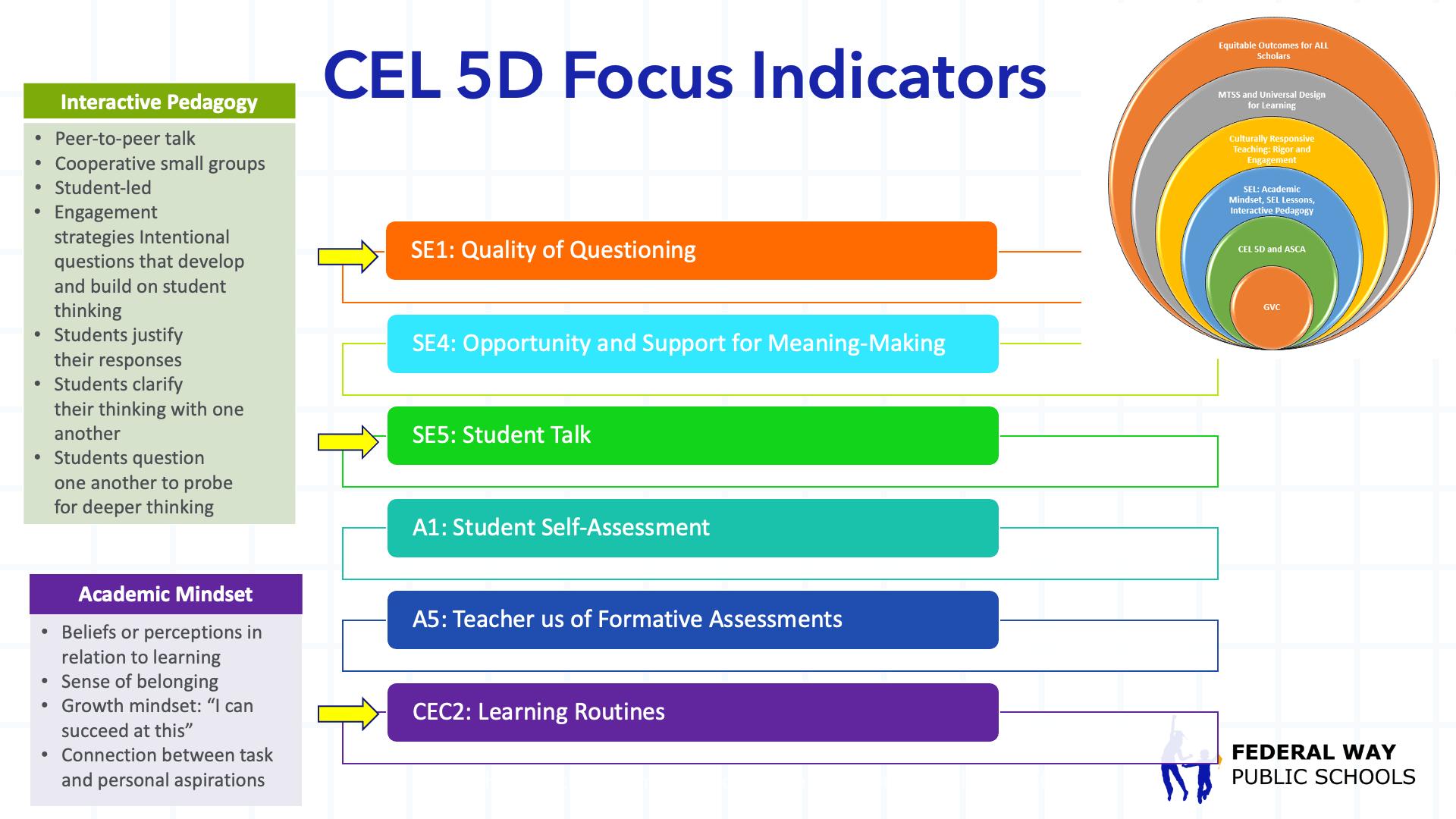
CEC 2: Learning Routines – This indicator at a Proficient level means that discussion and collaborative work are consistently present and result in effective scholar discourse.
• How do you achieve effective scholar discourse?
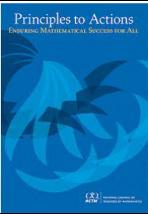
• First, teach your scholars the skills to listen and learn from one another through teaching clear expectations for pair shares (assign partners, partners take turns talking) and small group work such as Talk Moves, question stems and assuring that all scholars participate. Then, teach your scholars how to have meaningful learning conversations in pair shares and then small groups by sharing ideas, listening to understand others who might have different perspectives, comparing approaches, and asking questions. Meaningful partner talk and small group share outs should lead to strong whole group discourse.
SE5: Student Talk – Student talk at a proficient level is a mix of teacher-student and student-to-student. Talk reflects discipline-specific knowledge and ways of thinking. Students are expected to provide evidence to support their thinking.

SE1 Quality of Questioning – When questioning is at a proficient level, the teacher asks questions to probe and deepen student understanding or uncover misconceptions. In addition, the teacher assists students in clarifying their thinking with one another.
• How do you ask questions to probe and deepen student understanding or uncover misconceptions?
• Pose purposeful questions! The effective teaching of any content uses purposeful questions to assess and advance students’ reasoning and sense making about important ideas and relationships. Effective teaching relies on questions that encourage students to explain and reflect on their thinking as essential components of meaningful discourse. - adapted from Principles to Actions, page 35
As we start to expand our communication and learning about our multilingual scholars, it is important to start with language proficiency assessments and how we can leverage our services to ensure multilingual scholars access rigorous core content while valuing their cultural and linguistic assets.
What is WIDA?
Washington State has moved from ELPA21 to WIDA as the state approved language proficiency assessment. The purpose of the WIDA language proficiency assessment is to provide information that informs instructional planning and other decisions related to scholars’ education. Assessment results are intended to demonstrate the linguistic ability of our multilinguals and how to best support them across all content areas with a focus on Listening, Reading, Speaking and Writing.
What is the WIDA English Language Development Standards Framework?
Language development standards are the driver of equity
for multilinguals in curriculum, instruction, and assessment. The components of the WIDA ELD Standards Framework include:

1. WIDA ELD STANDARDS STATEMENTS – conceptual framing of language and content integration
2. KEY LANGUAGE USES – prominent language uses across disciplines
3. LANGUAGE EXPECTATIONS – goals for content-driven language learning
4. PROFICIENCY LEVEL DESCRIPTORS – a continuum of language development across six levels
What are the actual WIDA ELD Standards?
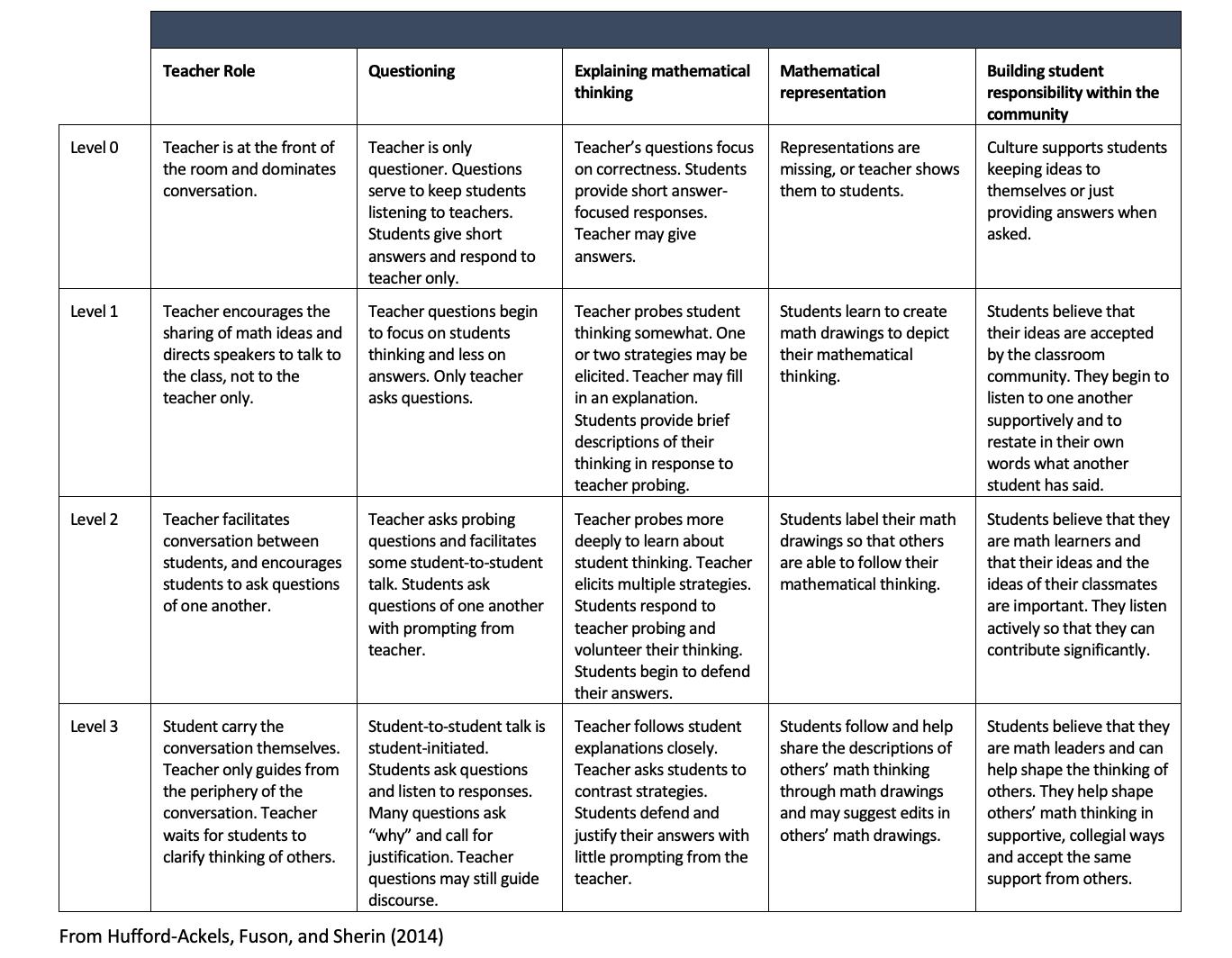 •
The rubric below is a great resource to understand the levels of classroom discourse:
•
The rubric below is a great resource to understand the levels of classroom discourse:
When thinking of CEL 5D, we can see how the framework supports all scholars but specifically our multilinguals through high quality and culturally responsive instruction. For example, the first semester we focused
on SE5: Scholar Talk and CEC2: Learning Routines and can see a consistent pattern of opportunities to ensure language development opportunities are happening for multilingual scholars across all content areas.
These opportunities include strategies aligned to CEL 5D:
• Encourage use of home languages to clarify new ideas
• Group scholars based on their academic language proficiencies to prevent gaps in abilities
• Teach scholars to provide one another sufficient wait time to produce responses
• Think, Pair, Share
• Intentional talk time
• Build a sense of community
• Replace hand raising with an expectation that all will be asked to respond at any time
• Greet all scholars by name as they enter the room
• Build expectations that scholars help one another clarify ideas being expressed
Nearpod is a K-12 district resource that allows certificated staff to create interactive lessons by using PowerPoint, Google Slides, PDFs, and embedded tools to promote formative assessment, feedback, student talk, and scholar engagement. All FWPS K-12 certificated teachers, administrators, and support staff have premium Nearpod accounts through Google (@p12fwps.org email) to support MTSS and FWPS’ focus CEL 5D indicators in learning. Here are some ways you can learn more about integrating Nearpod into your lesson planning:
• Join and work through the following self-paced Nearpod lesson to explore and experience how to log in to Nearpod and utilize Collaborate Boards and Draw It activities to support Student Talk in the classroom.
◊ Access the self-paced Nearpod lesson by clicking the following link: Click Here

• To continue your own learning, enroll in the Nearpod Winter/Spring 2023 self-paced online Canvas training.
◊ Visit the CLC and navigate to February 13, 2023 to find all 3 Nearpod course offerings.
◊ After requesting a course, use the self-enroll link to begin your training. (Log-in to Launchpad and Canvas prior to clicking the link)
What is Blended Learning? Blended Learning is active engaged learning online combined with active engaged learning offline - with the goal of giving scholars more control over their learning experience, specifically control over time, place, pace, and/or path. Blended Learning is also something that is already happening every day in many of our classrooms.
As we focus on key indicators for effective instruction from our CEL 5D instructional framework, we can be intentional in the way we incorporate blended learning strategies in order to give scholars more control of time, place, pace, and path, while creating opportunities for more 1 to 1 and small group instruction and feedback. In line with Universal Design for Learning (UDL), Blended Learning can also provide scholars with multiple means for engaging in “student talk.” Focusing on SE5, Student Talk, and CEC2, Learning Routines, here are some ways to leverage blended learning to support scholar discourse strategies.
“Turn and Talk”- In a brick and mortar classroom, we often have scholars turn and talk with an elbow partner to share ideas. A Canvas discussion can be used to provide scholars with another way to engage in discourse with one or more classmates in response to a prompt. It also allows teachers to see the responses of all scholars. It also allows scholars to respond to anyone in the classroom, not just those in close proximity. Check out these guides to see how to set up a Canvas discussion:
• How do I create a discussion as an instructor?
• Teacher Video Guide (Canvas Discussions Video)
• Student Video Guide (Canvas Discussions Video)
“Collaborative Board-Group Poster - Shared Butcher Paper” - Oftentimes we have groups document their thinking problem solving on a shared poster or on butcher paper. We can create engaged online learning through the use of shared documents: Google Docs, Google Slides, Shared Word Doc. Scholars can contribute to these shared docs in real time, or from any place, at their own pace, and at asynchronous times. It also creates a way to memorialize group thinking without taking up limited classroom wall space. Check out these guides with videos to see how shared documents can be used:
• Share a document - Microsoft Support
• Google Docs Training | Teacher Center | Google for Education
A tool that allows the teacher to facilitate multiple types of scholar discourse, in many different formats (video, typed response, sound recordings, images and more) is Padlet In class, one can use the Padlet “shelf” template to create multiple prompts that scholars would respond to. Each column could be a different prompt for scholar response used throughout a lesson:
Check out this resource to learn more about Padlet:
• Padlet Reference Guide
Reach out to your building Technology Integration Coach or Blended Learning Coach to get support in planning the integration of Blended Learning Strategies, or join our Teaching for Learning Instructional Technology team during office hours one Wednesdays, from 8-9 am or 3-4 pm at this Zoom Link: https://fwps.zoom.us/j/93305900238

This year, we are continuing our shift to more inclusively identifying scholars who may need additional services/ supports in their classroom environment and differentiating those services/supports through inclusive learning opportunities (meaning expanding upon the topics/ standards being taught and including other scholars in a classroom who demonstrate academic readiness).
One approach might be using a UDL- Planning for Variability lens to modify the Essential Question of a GVC unit. For example, in Third-Grade: Module 1, the Essential Question has scholars consider how “… where people live in the world affects how they access reading and books?” A Third-Grade team may choose to modify this question as part of their Highly Capable services – asking their cluster group to answer the initial question and then compare and contrast four unique countries of their choice, outlining what specific factors impact the differences.
In this example…
• Highly Capable identified scholars are part of the whole-class unit and instruction
• Any scholar in class who shows readiness (whether HC identified or not) can access and participate
• Their extension activity can be introduced and supported through small group instruction within their cluster groups.
• This reading activity could instructionally extend into writing instruction as well, supporting cluster groups through small group instruction specifically about their project.

• Additionally, the whole class’s learning can be enhanced by having the Cluster groups share their learning from their compare and contrast research projects.
For more inclusive, standards-based Cluster Grouping ideas, please check out our HCP Updates & Revisiting Cluster Grouping Video
Integrating student leadership development is a vital component of all CTE courses, allowing scholars to practice, develop, and demonstrate the knowledge and skills learned through the CTE course or program of study. As an integral part of increasing 21st Century skills, developing student leadership skills through CTE courses empowers CTE scholars to assume responsibility for building positive relationships with family, community, and business and industry environments. There are two ways to incorporate student leadership skills development in CTE courses. The first is to create opportunities for our CTE scholars to join a specific Career and Technical Student Organization (CTSO) such as DECA and FFA. The second is to offer an equivalency program. Equivalent leadership programs should include community service activities related to the class. Scholars should also participate in related leadership activities outside the classroom at the local, regional, state, and/or national level and be engaged in activities that extend learning beyond the classroom/ laboratory into the community that provides real-world value. If you would like to know more about integrating scholar leadership into your courses, please contact Fredolyn Armstrong.

Winter testing windows are on the horizon. This year, grades K-5 will test in January and grades 6-10 will test in February. As scholars prepare for the winter diagnostic, it is good practice to have them goal set. Our goal this year is to have scholars meeting their stretch growth by the end of the year. By January/February, scholars should have met 50%-60% of their stretch growth. So scholars who have a goal of 44 should have raised their iReady scale score by 22-26 points. Staff can find stretch growth goals in their iReady Diagnostic Results Report.

Kindergarten online registration will open on January 17, 2023 for scholars who will be 5 years old before August 31, 2023. Families can visit https://www.fwps. org/Page/7199 to register.
WaKIDS 101 is a required online training for all kindergarten teachers and ACP/FCP teachers with kindergarten scholars in their classrooms. The training is being made available during January and February for any current kindergarten or ACP/FCP teachers that have not taken the course but will be returning next year in the same position and will need to have the training completed. The training will be made available again in July, 2023 but it may be helpful to staff to complete this training prior to the end of the school year to ensure they are ready for the implementation of the WaKIDS assessment in Fall, 2023. Staff can visit this link to register for the course.


Did you know you can access the Standards Based Grading and Reporting Handbook through Launchpad to Learning? Within the handbook, you can review the 6 Principles of Grading, how formative and summative assessments communicate scholar learning, rubrics for the Behaviors that Promote Learning by level, sample report cards, and more. As we prepare for report cards, within the Vhandbook on page 12 is a video on how grades are calculated

Additionally, this year, we have added videos to the parent portal that explain the grading calculations for priority standards, reporting standards, and, for secondary scholars, the final grade. If you have families who are wondering how grades are calculated, you can send them to the parent portal. Each video is translated into our top 11 languages.
As we focus collectively on Multitiered Systems of Support (MTSS), what does this mean for scholars with disabilities? Multi-tiered systems of support are intended to meet the needs of all learners, including students with disabilities. All students should receive Tier 1 supports. Tier 2 and Tier 3 supports are not intended to replace Tier 1 supports. At different points in their educational journey, any one student may need the supports in tiers 2 and 3 and should have equitable access to these. In addition, tier 3 supports are not synonymous with special education.
In an MTSS system, scholars should move fluidly through the tiers. Scholars eligible for special education services are entitled to specially designed instruction to address their unique needs and to ensure access to the general curriculum so they can meet educational standards. Therefore, in many cases, scholars with disabilities will need supports including targeted and/or intensive interventions. This may include accommodations, modifications, services and instructional interventions within and across a continuum of educational supports.
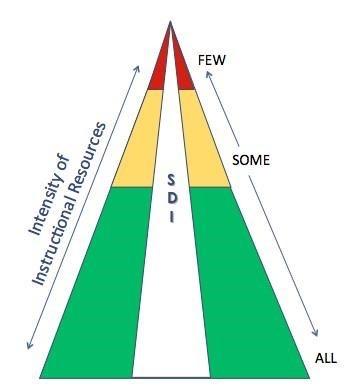
Within an MTSS system SDI and scholar progress is carefully monitored and decisions about the effectiveness of interventions are data based, the same is true for IEP services, in fact, it’s a requirement of the Individuals with Disabilities Act (IDEA) to ensure scholar’s are receiving a free appropriate public education (FAPE). Progress towards IEP goals and access and progress towards general education standards must be carefully monitored and changes to interventions, supports, and/or services must be made when there is data to success a scholar is not progressing sufficiently. Tips for teams to in monitoring progress include:
• Make sure IEP goals are written in observable, measurable terms that also facilitate easy progress monitoring. Goalbook is an excellent tool to aid in this process. Monitor progress towards all IEP goals frequently (at least 2 time a month, preferably once a week) as indicated in the IEP. Visual graphing is highly recommended, as it allows you to visually track if a scholar is on pace to reach their goal.
• Stay in close communication with general education teachers to ensure scholars are accessing and making progress towards the general education standards with appropriate accommodations and modifications.
• Communicate with families early and often when scholars are not making sufficient progress and document changes to interventions. If these changes to interventions include changes to IEP services and supports, document these changes in the IEP through an amendment and prior written notice.
As we engage in professional development and grow in our practice of increasing scholar engagement and success, we are focusing on six CEL 5D indicators. What does this look like in special education settings?


collaborative conversations and to express their thinking with one another.
For teachers using our direct instruction supplemental curriculum, it’s important that you take opportunities to also engage in collaborative conversations and pair or group work. One example of how to do this in Math is by using our Routines for Reasoning lessons. These are teacher developed activities that focus on building mathematical thinking and reasoning skills through learning routines such as capturing quantities, connecting representations, recognizing repetition and three reads that are aligned to units within Connecting Math Concepts.
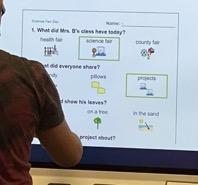
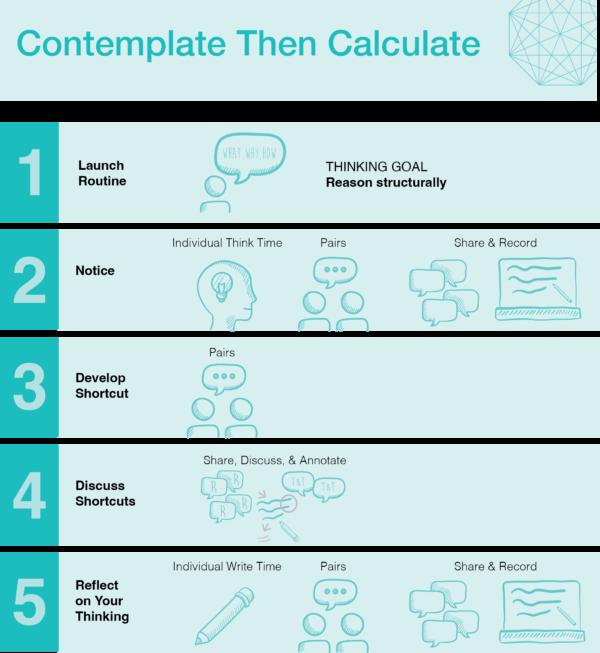
Special educators can impact scholar success by explicitly teaching specific learning routines. This includes learning routines used within special education environments but also taking time to break down, explicitly teach and practice learning routines used in scholars’ general education settings. This practices is in alignment with High Leverage Practices in Special Education HLP 14, 15 and 18. Often times, scholars with disabilities will need multiple opportunities and very explicit instruction and practice to learn and engage in learning routines in multiple settings. Providing visual supports and sentence stems are also effective strategies for teaching and supporting learning routines and may be necessary accommodations for scholars with disabilities. At our Employment and Transition program teachers and therapists have been explicitly teaching learning routines to help scholars engage in collaborative discussions both in the classroom and in community settings.
Just like learning routines, increasing scholar talk is vital to increasing scholar engagement, ownership of the learning process and self-efficacy. Scholars must have opportunities to engage in problem solving and collaborative learning, as well as, talk about their learning and thinking with one another. Just like learning routines, scholars with disabilities can benefit from explicit teaching and practice in how to engage in
For teachers and therapists working with scholars with complex communication needs, scholar talk is also vital. Working collaboratively to ensure access to visuals and appropriate assistive technology can aid in increasing scholar talk. Unique Learning Systems (ULS) has visuals to support collaborative or individual scholar talk tied to lessons through the use of SymbolStix (included in ULS). Shannon Withrow, an FCP teacher at Star Lake, uses these tools to increase scholar talk during an ULS ELA lesson as she supports scholar talk in the area of reading comprehension.
As we know, we are all relational beings and a sense of belonging is a fundamental need as it is a major factor that contributes positively to our phycological development. In addition to supporting mental health, a sense of belonging positively affects engagement, behavior and academic performance. Our Vision for Excellence and Equity states that we are committed to ensuring that each and every scholar feels included, so that they can: 1) be seen, heard, valued, and celebrated for who they are and 2) be socially and emotionally safe at school in the educational environment: curriculum, instruction, school and classroom culture, and activities.
Below are some ways in which you can continue to encourage a sense of belonging.
Social-emotional learning (SEL) is the process of developing skills such as self-awareness, self-control, and interpersonal skills necessary for success in school, work and everyday life.

People with strong social-emotional skills are better able to cope with everyday challenges and benefit academically, professionally and socially. The following skills help with problem-solving, emotion management and impulse control and work to provide scholars with a foundation for long-term, successful lives.
By embedding opportunities to promote social-emotional learning into the fabric of the school day, educators can support students in building on their existing competencies in an authentic way within the context of a positive learning environment.
• Grades PK-5: The GVC for SEL in grades PK-5 include Second Step and at K-5, the Bullying Prevention Unit. The Elementary Instructional Planning course on Canvas includes an SEL section for each grade level K-5. The following resources can be found and utilized: pacing guide, Curriculum Overview Guide, getting access to Second Step online, aligned book lists for K-2 & 3-5, and Restorative Practices Second Step guide.
SEL Integration Tips: Each Second Step and Bullying Prevention lesson includes daily practice activities for Days 2-5, which can be embedded throughout the week to reinforce the main lesson content. Brain builders promoting executive functioning skills are available for grades K-3. These quick, engaging activities can be used during transition times.
• Grades 6-12: Schools are utilizing advisory time to promote and teach SEL in various ways. To support school and teacher efforts, SEL, HIB, CCR, and Digital Citizenship lessons have been created or provided each month on the Secondary Instructional Planning course on Canvas--> Secondary Advisory Lessons. Even though lessons have been linked to specific months, teachers may access any lessons throughout the school year.
SEL Integration Consideration: Ask scholars which SEL competencies (see above) will they need to use during various learning routines in your class? Then have them self-assess or group assess how they used the SEL skill at the end of the instructional time.
Relationship Skills Social Management
Responsible Decision-Making Social Engagement
While the SEL competencies work to serve as a foundation for achieving academic goals, academic instruction also provides a ripe opportuni ty for teaching and practicing SEL. Through schoolwide SEL, your team can ensure that SEL is woven throughout academic instructional time to support and deepen learning.
During the 22-23 school year, FWPS is undergoing a curriculum adoption for a Social Emotional Learning curriculum in grades 6-12. We need secondary teachers to lend their expertise and voice to both the curriculum adoption team and SEL curricula pilots. The goal is to have staff from each secondary school involved as well as representation of teachers across content areas and grade levels. The adoption committee will begin to meet weekly in January with SEL curricula pilots starting in mid-February. If you are possibly interested in this opportunity, please complete Secondary SEL Curriculum Adoption Interest Form and more information will be forthcoming. Thank you!
Federal Way Public Schools is rich in culture with a scholar community that can speak more than one hundred different languages. We are a school district that embraces diversity, values each and every scholar’s experiences, and honors every family’s religious beliefs and traditions. This diversity is reflected in the national observances celebrated every month.

January 1
January 6
New Year’s Day
JanuaryArmenian Orthodox Christmas
January 6 Epiphany
January 7 Eastern Orthodox Christmas
January 7 Mahayana New Year
January 15 Makar Sankranti
January 15 World Religion Day
January 16 Dr. Martin Luther King Jr. Day
January 16-20 No Name-Calling Week
January 20 Guru Gobind Singh Ji’s Birthday
January 22 Lunar New Year
January 27 UN Holocaust Memorial International Day of Commemmoration
We would like to highlight a few observances for the month of January and February to provide our staff with insights into our scholars’ diverse cultural and religious beliefs and practices:
To view the full 2022 - 2023 Cultural & Religious Calendar please visit: https://www.fwps.org/Page/4414
Black History Month
February
African American History Month
February 1 National Freedom Day
February 5-6 Tu BiShvat
February 14 Valentine’s Day
February 15 Nirvana Day
February 15 Susan B. Anthony Day
February 18 Maha Shivaratri
February 19-25 Aromantic Awareness Week
February 20 President’s Day
February 20 World Day of Social Justice
February 21 Shrove Tuesday
February 22 Ash Wednesday
February 25March 1 Ayyám-i-ha OR Intercalary Days OR “Days of Ha”
We in FWPS believe that while heritage months are great as they work to provide the space to teach and learn about cultural history, and to examine the way in which these cultures are viewed, we know that in order to increase belonging, we know we need to move past the month. We want our schools to be a mirror of our community – a place where every scholar has a sense of belonging and can be seen, valued, and heard. Our scholars benefit from learning about and celebrating all cultures.
November was National Native American Heritage Month, a time that our district and schools celebrated the significant and countless contributions, rich and diverse ancestry, cultures, traditions, and histories of our nation’s first people. To view some of the event that we engaged in during the month please use the following link: https:// www.fwps.org/nahm
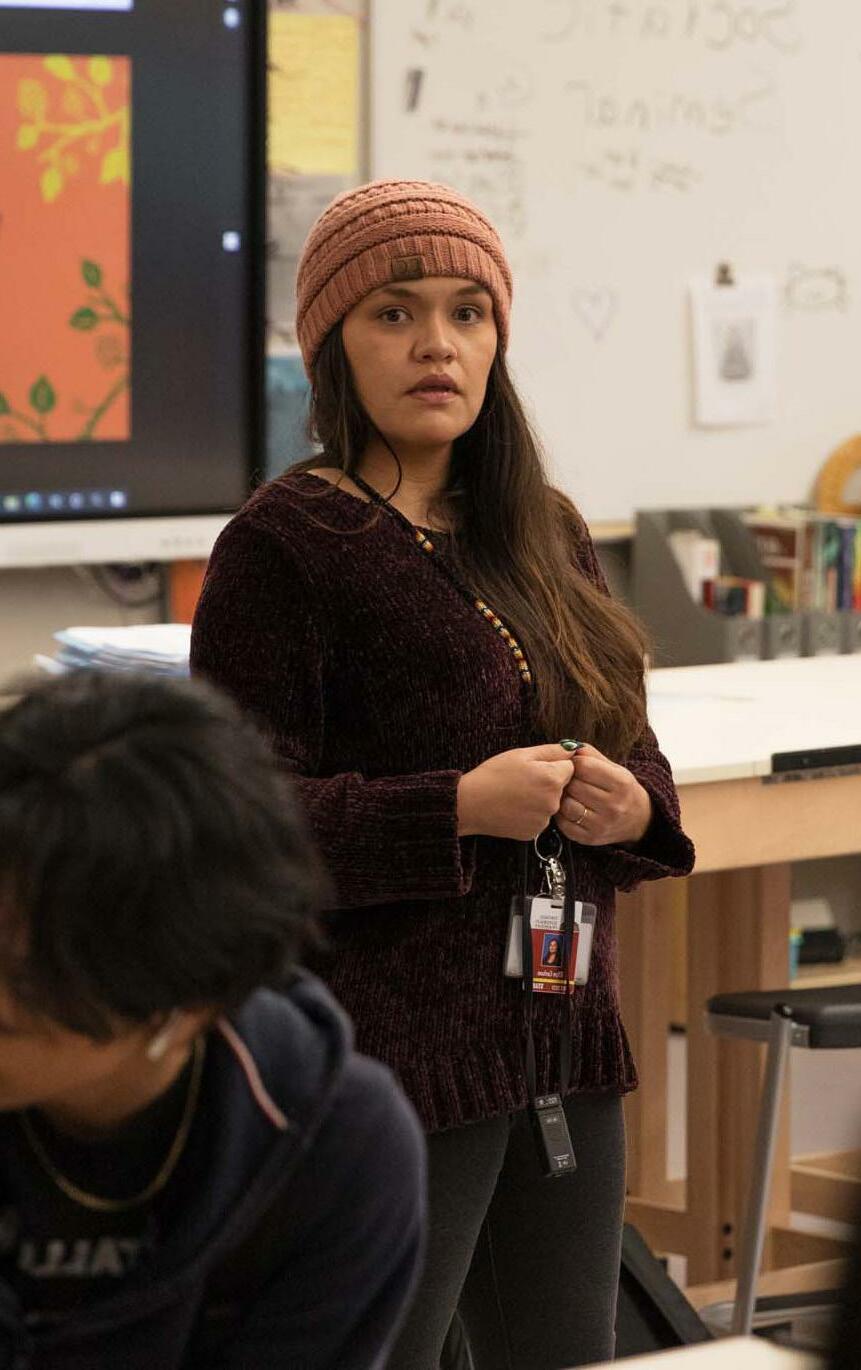
Additionally, please visit our FWPS Native Education on Canvas for information on Native Education and links to some great resources.
School staff play a key role in addressing chronic absence. The good news is that you don’t have to solve this alone. You can:
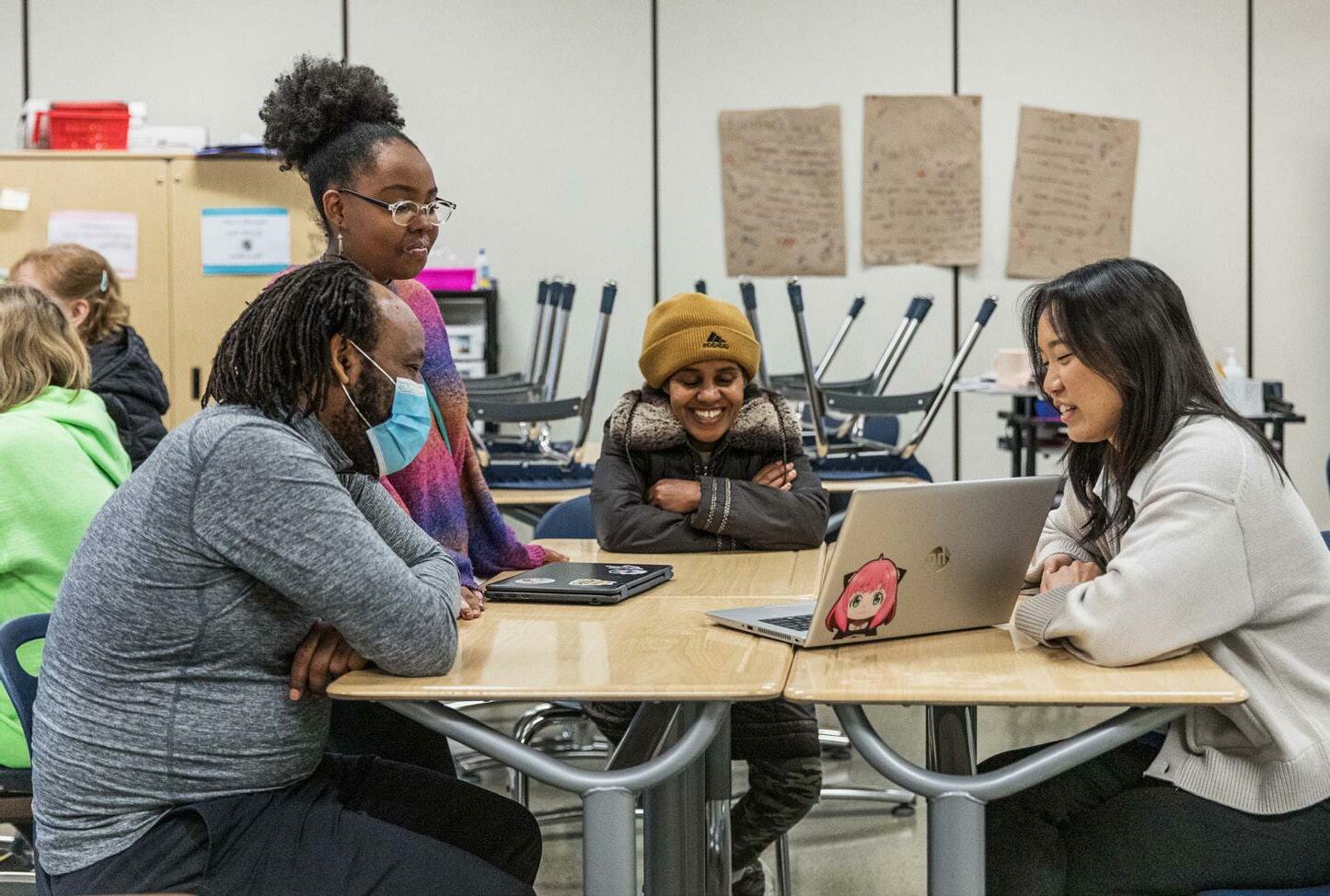
• Take roll regularly showing students that you care when they miss school.
• Reach out to frequently absent students to find out in a supportive manner why they are missing school and what would help them attend more regularly.
• Work with parents to stress the importance of early education and to learn about any barriers to good attendance.
• Create a nurturing, engaging classroom that will encourage children to come to school. Work with colleagues to develop and implement a school-wide system of incentives and rewards for good attendance.
• Encourage families to partner with other school staff, such as social workers or nurses, as well as community agencies to get needed supports to help children and families solve a significant barrier to getting to school.
Attendance WorksResearch shows that LGBTQIA+ scholars are more likely to face bullying and harassment, leading to poor grades, higher dropout rates, and homelessness. Safe and affirming schools are a core element of scholar success. Below is a resource that can be used to support FWPS staff in creating an environment that is welcoming and inclusive for scholars of all gender identities. Our Vision for Excellence and Equity states that we are committed to

each and every scholar, including our LGBTQIA+ community, so that they can: 1) be seen, heard, valued, and celebrated for who they are and 2) be socially and emotionally safe at school in the educational environment: curriculum, instruction, school and classroom culture, and activities.
All scholars have the right to safety, dignity, inclusion at school, and are protected from discrimination and harassment based on gender identity by federal law, state law, and district policies. For more information, please see the FWPS Gender Inclusive Policy 3211 and Procedure 3211 or contact the Office of Equity.
Homelessness is an experience that any individual can face due to lack of fixed, regular or adequate or nighttime residence. When most people think of homelessness, they have a picture in their mind of a person who is visibly suffering from extreme poverty. However, homelessness comes in many forms. Sharing housing, couch surfing, staying in a shelter, or a hotel are experiences of homelessness. Homelessness can be caused by medical expenses, house fires, natural disasters, war, domestic violence, and other situations that can be life altering. Also, due to rising house prices and an increase in the cost of living, finding a permanent house is becoming harder for too many families.
For students experiencing homelessness, school stability may be the only form of stability in their life. Teachers play a crucial role in creating a classroom environment that is safe and supportive for all scholars, especially those who are highly mobile and have experienced the trauma that often accompanies homelessness.
Teachers can play a critical role in the lives of students who are homeless. While McKinney-Vento liaisons bear
the local-level legal responsibility for serving students experiencing homelessness, teachers are well-positioned to observe and respond to student needs. Some strategies for providing support include:
1. Learn more about the McKinney-Vento Act and connect with your local liaison. (There is a canvas course that is housed on your main screen.
2. Create a welcoming climate and build trust with all students.
3. Help to identify and support students experiencing homelessness and connect them with your building liaison.
4. Take a trauma-informed approach.
5. Ensure classroom policies and procedures set students up for success.
Below are some additional resources:
• Video from SchoolHouse Connection
• The Hidden Problem of Homeless High School Students
• Article from SchoolHouse Connection
